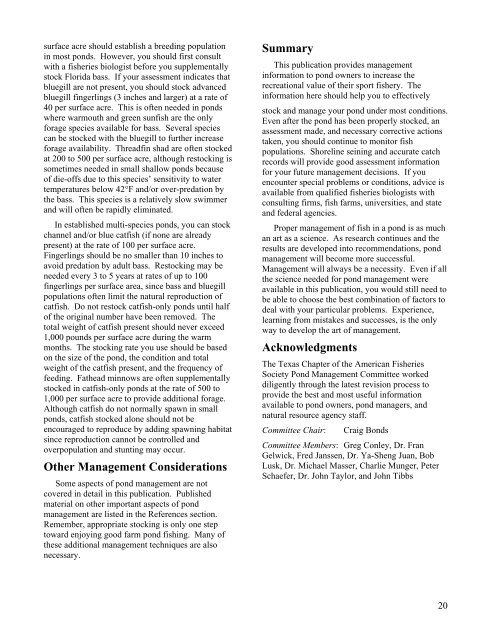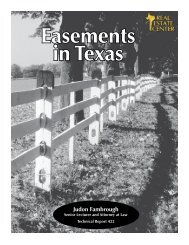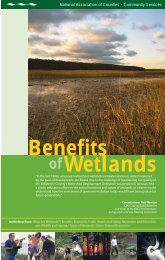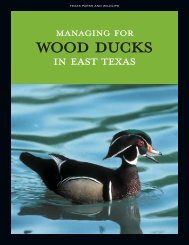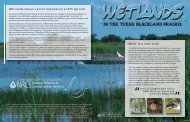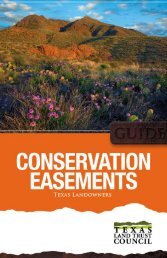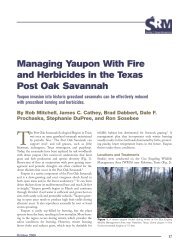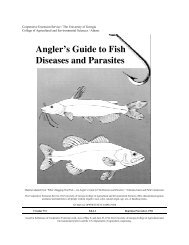Texas Farm Ponds: Stocking, Assessment, and Management ...
Texas Farm Ponds: Stocking, Assessment, and Management ...
Texas Farm Ponds: Stocking, Assessment, and Management ...
You also want an ePaper? Increase the reach of your titles
YUMPU automatically turns print PDFs into web optimized ePapers that Google loves.
surface acre should establish a breeding population<br />
in most ponds. However, you should first consult<br />
with a fisheries biologist before you supplementally<br />
stock Florida bass. If your assessment indicates that<br />
bluegill are not present, you should stock advanced<br />
bluegill fingerlings (3 inches <strong>and</strong> larger) at a rate of<br />
40 per surface acre. This is often needed in ponds<br />
where warmouth <strong>and</strong> green sunfish are the only<br />
forage species available for bass. Several species<br />
can be stocked with the bluegill to further increase<br />
forage availability. Threadfin shad are often stocked<br />
at 200 to 500 per surface acre, although restocking is<br />
sometimes needed in small shallow ponds because<br />
of die-offs due to this species’ sensitivity to water<br />
temperatures below 42°F <strong>and</strong>/or over-predation by<br />
the bass. This species is a relatively slow swimmer<br />
<strong>and</strong> will often be rapidly eliminated.<br />
In established multi-species ponds, you can stock<br />
channel <strong>and</strong>/or blue catfish (if none are already<br />
present) at the rate of 100 per surface acre.<br />
Fingerlings should be no smaller than 10 inches to<br />
avoid predation by adult bass. Restocking may be<br />
needed every 3 to 5 years at rates of up to 100<br />
fingerlings per surface area, since bass <strong>and</strong> bluegill<br />
populations often limit the natural reproduction of<br />
catfish. Do not restock catfish-only ponds until half<br />
of the original number have been removed. The<br />
total weight of catfish present should never exceed<br />
1,000 pounds per surface acre during the warm<br />
months. The stocking rate you use should be based<br />
on the size of the pond, the condition <strong>and</strong> total<br />
weight of the catfish present, <strong>and</strong> the frequency of<br />
feeding. Fathead minnows are often supplementally<br />
stocked in catfish-only ponds at the rate of 500 to<br />
1,000 per surface acre to provide additional forage.<br />
Although catfish do not normally spawn in small<br />
ponds, catfish stocked alone should not be<br />
encouraged to reproduce by adding spawning habitat<br />
since reproduction cannot be controlled <strong>and</strong><br />
overpopulation <strong>and</strong> stunting may occur.<br />
Other <strong>Management</strong> Considerations<br />
Some aspects of pond management are not<br />
covered in detail in this publication. Published<br />
material on other important aspects of pond<br />
management are listed in the References section.<br />
Remember, appropriate stocking is only one step<br />
toward enjoying good farm pond fishing. Many of<br />
these additional management techniques are also<br />
necessary.<br />
Summary<br />
This publication provides management<br />
information to pond owners to increase the<br />
recreational value of their sport fishery. The<br />
information here should help you to effectively<br />
stock <strong>and</strong> manage your pond under most conditions.<br />
Even after the pond has been properly stocked, an<br />
assessment made, <strong>and</strong> necessary corrective actions<br />
taken, you should continue to monitor fish<br />
populations. Shoreline seining <strong>and</strong> accurate catch<br />
records will provide good assessment information<br />
for your future management decisions. If you<br />
encounter special problems or conditions, advice is<br />
available from qualified fisheries biologists with<br />
consulting firms, fish farms, universities, <strong>and</strong> state<br />
<strong>and</strong> federal agencies.<br />
Proper management of fish in a pond is as much<br />
an art as a science. As research continues <strong>and</strong> the<br />
results are developed into recommendations, pond<br />
management will become more successful.<br />
<strong>Management</strong> will always be a necessity. Even if all<br />
the science needed for pond management were<br />
available in this publication, you would still need to<br />
be able to choose the best combination of factors to<br />
deal with your particular problems. Experience,<br />
learning from mistakes <strong>and</strong> successes, is the only<br />
way to develop the art of management.<br />
Acknowledgments<br />
The <strong>Texas</strong> Chapter of the American Fisheries<br />
Society Pond <strong>Management</strong> Committee worked<br />
diligently through the latest revision process to<br />
provide the best <strong>and</strong> most useful information<br />
available to pond owners, pond managers, <strong>and</strong><br />
natural resource agency staff.<br />
Committee Chair: Craig Bonds<br />
Committee Members: Greg Conley, Dr. Fran<br />
Gelwick, Fred Janssen, Dr. Ya-Sheng Juan, Bob<br />
Lusk, Dr. Michael Masser, Charlie Munger, Peter<br />
Schaefer, Dr. John Taylor, <strong>and</strong> John Tibbs<br />
20


